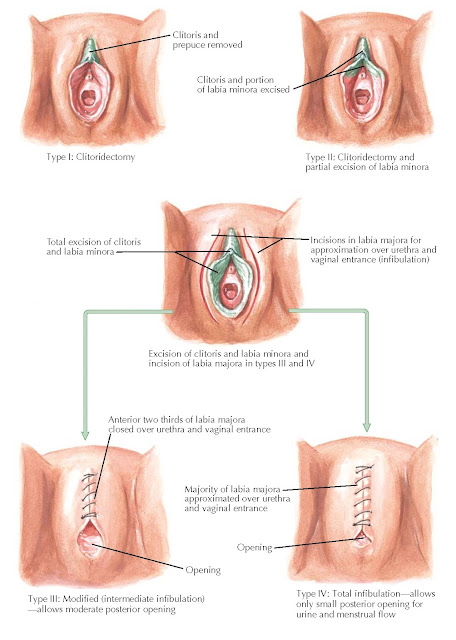FEMALE CIRCUMCISION
Female circumcision is a culturally determined practice of ritually cutting a female’s external genitals that results in removal of part or all of the external genitalia including the labia majora, labia minora, and/or the clitoris. This activity is illegal in many locations. Female circumcision (female genital mutilation, infibulation) is generally performed as a ritual process, often without benefit of anesthesia and frequently under unsterile conditions, generally near the time of puberty or soon after. The resulting scarring may preclude intromission or normal vaginal delivery should pregnancy be achieved. In rare cases, scarring and deformity may be sufficient to result in amenorrhea or dysmenorrhea. The ritual is often performed to reinforce a woman’s place in her society, to establish eligibility for marriage and entry into womanhood. It is sometimes also performed to safeguard virginity or to paradoxically improve fertility. Although the ritual can have devastating effects on the woman’s sexual pleasure, it is some- times performed to enhance the husband’s pleasure.
The amount and location of tissue removed determine the type of
infibulation:
Type I—excision of the prepuce, with or without excision of part of or
the entire clitoris.
Type II—excision of the clitoris with partial or total excision of the
labia minora. (This is the most common form.)
Type III—excision of part or all of the external genitalia and
stitching/narrowing of the vaginal opening (infibulation).
Type IV—pricking, piercing, or incising of the clitoris and/or labia;
stretching of the clitoris and/or labia; cauterization by burning of the
clitoris and surrounding tissue.
Other forms of female genital mutilation include the following:
Scraping of the tissue surrounding the vaginal orifice (angurya cuts) or
cutting of the vagina (gishiri cuts) or the introduction of corrosive
substances or herbs into the vagina to cause bleeding or for the purpose of
tightening or narrowing the vagina.
 |
| Plate 6-18 |
It has been estimated that more than 130 million women worldwide have
undergone some form of female circumcision. Although uncommon in the United
States (estimated to be 168,000 in the United States, with 48,000 younger than
18 years), more than 95% of women in some countries (e.g., Somalia) have had
one of these procedures.
These patients may experience bleeding and infection (including tetanus),
urinary retention, and pain at the time of the original procedure. Long term,
the patient may experience sexual dysfunction, difficulty with menstrual
hygiene, recurrent vaginal or urinary tract infections, retrograde
menstruation, hematocolpos, or chronic pelvic inflammatory disease. Excessive
scarring, including keloid formation, adhesions, and pelvic and back pain are
all common. Initiation of sexual activity may also
present medical complications for the infibulated woman. For example, if her
narrow introitus tears “naturally” (by penile penetration), local infections
and laceration of adjacent tissues may occur, leading to possible further
complications. Increasingly, women are consulting physicians prior to
initiating sexual activity and requesting deinfibulation.
Surgical opening of fused or scarred genital tissue may be necessary to
allow for menstrual hygiene and sexual function.
An anterior episiotomy, with or without subsequent repair, may be required at
the time of child-birth. (Subsequent repair of the episiotomy is illegal in
some locations, such as the United Kingdom and others, because this amounts to
reinfibulation.) Sexual sequelae are often lifelong despite surgical revision
(especially when clitoridectomy has been performed). Care for these women must
be provided in a nurturing, nonjudgmental
way.




